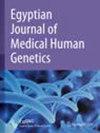Cellulose acetate electrophoretic separation of serum and urine proteins in Nigerian children with autism spectrum disorders
IF 1.1
Q4 GENETICS & HEREDITY
引用次数: 0
Abstract
Autism spectrum disorder (ASD) is a neurodevelopmental disorder (NDD) characterized by social communication challenges and restricted, repetitive behaviors. While genetic and environmental factors are known to contribute to ASD, the role of the immune system remains unclear. This study investigated the separation patterns of serum and urine proteins in Nigerian children with ASD compared to typically developing children and children with other NDDs. Forty-seven participants aged 3–8 years were recruited, including 16 children diagnosed with ASD and 16 children with other NDDs, both according to DSM-5 criteria, along with 15 neurotypical children. Blood and urine samples were collected for protein analysis. Total protein and albumin levels were measured in both serum and urine using established methods. Protein separation in serum and urine was performed using cellulose acetate electrophoresis, followed by densitometry analysis of the electrophoretic patterns. The results revealed no significant differences in total serum protein levels and most protein fractions between the groups. However, children with other NDDs exhibited significantly lower levels of alpha-2 globulin compared to neurotypical children. Conversely, both ASD and NDD groups showed significantly higher gamma globulin levels compared to the control group. Interestingly, spot urine protein levels were significantly higher in children with ASD compared to neurotypical children. The observed changes in alpha-2 and gamma globulin levels suggest potential immune system involvement in ASD and other NDDs. The higher urine protein excretion in the ASD group warrants further investigation to explore the potential of urinary protein biomarkers for ASD diagnosis.尼日利亚自闭症谱系障碍儿童血清和尿液蛋白质的醋酸纤维素电泳分离
自闭症谱系障碍(ASD)是一种神经发育障碍(NDD),其特征是社交沟通障碍和限制性重复行为。虽然已知遗传和环境因素会导致 ASD,但免疫系统的作用仍不清楚。本研究调查了尼日利亚 ASD 儿童与发育正常儿童和其他 NDD 儿童的血清和尿液蛋白质分离模式。研究共招募了 47 名 3-8 岁的参与者,其中包括 16 名根据 DSM-5 标准诊断为 ASD 的儿童和 16 名患有其他 NDD 的儿童,以及 15 名神经正常的儿童。研究人员采集了血液和尿液样本进行蛋白质分析。采用既定方法测量血清和尿液中的总蛋白和白蛋白水平。使用醋酸纤维素电泳法对血清和尿液中的蛋白质进行分离,然后对电泳图样进行密度分析。结果显示,各组之间的血清总蛋白水平和大多数蛋白质组分没有明显差异。然而,与神经畸形儿童相比,患有其他 NDD 的儿童的α-2 球蛋白水平明显较低。相反,与对照组相比,ASD 组和 NDD 组的γ 球蛋白水平都明显较高。有趣的是,与神经畸形儿童相比,ASD 儿童的点尿蛋白水平明显更高。观察到的α-2和γ球蛋白水平变化表明,ASD和其他NDD可能与免疫系统有关。ASD 组尿蛋白排泄量较高,这值得进一步研究,以探索尿蛋白生物标记物在诊断 ASD 方面的潜力。
本文章由计算机程序翻译,如有差异,请以英文原文为准。
求助全文
约1分钟内获得全文
求助全文
来源期刊

Egyptian Journal of Medical Human Genetics
Medicine-Genetics (clinical)
CiteScore
2.20
自引率
7.70%
发文量
150
审稿时长
18 weeks
 求助内容:
求助内容: 应助结果提醒方式:
应助结果提醒方式:


